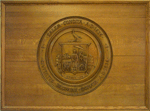Count Rumford
Count Rumford,(1753-1814) for whom the Rumford fireplace is named, was born Benjamin Thompson in Woburn, Massachusetts in 1753 and, because he was a loyalist, he left (abruptly) with the British in 1776.
Rumford's father died at age 26 when Benjamin was only 2 years old. At 13, his guardian Joshua Simonds apprenticed Benjamin to Appleton in Salem.
Rumford was apprenticed to John Appleton who traded in salt fish. He lived with Appleton in the Georgian Colonial house (built in 1755) at 314 Essex St. Known as the Lindall-Gibbs-Osgood house in the book, Architecture in Salem. It has alternately been known as the "Rumford House" and the "Red Cross" house. The American Red Cross bought it in 1947 and used it until the mid 1990's when it was changed over to offices.
While in Salem he attended the village school. He was extremely bright and excelled in mathematics, astronomy, and making mechanical devices.
He spent much of his life as an employee of the Bavarian government where he received his title, "Count of the Holy Roman Empire." He is primarily known for the work he did on the nature of heat. Back in England, Rumford applied his knowledge of heat to improve the heat coming from fireplaces. He made them smaller and shallower with widely angled covings so they radiated heat better. It became known as the Rumford Fireplace.
Another one of Count Rumford's inventions was the Rumford Roaster. It transferred cooking from the open fire to an enclosed oven (the round opening, lined with metal inside), which was heated by the small square firebox directly below. There are openings in the sides of the oven to control the temperature, and the entire device was vented through the central chimney. The Rumford Roaster at Hamilton Hall is characteristic of the earliest examples in that it was built into the hearth.
See Also
- Card from the "Snag File" at the Ref. Desk
- Vertical File in Salem Collection - Lindall House
- Memoir of Benjamin Thompson, Count Rumford : with notices of his daughter by G.E. Ellis, pub. 1972
- Architecture in Salem Lindall-Gibbs-Osgood House, by B. Tolles, p. 180
- Rumford Roasters Streets of Salem blog
- House History H.S.I. (314 Essex Street)
